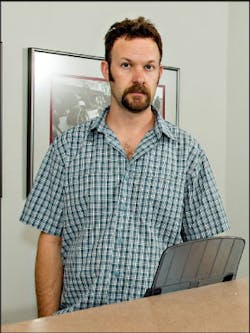Bart Lind refers to them as “boutique” repair shops—those fancy, high-end Euro facilities where the physical surroundings of the waiting room and shop are becoming almost more important to customers than the quality of service.
“It is what it is,” he says. “That wasn’t the case even 10 years ago, but the days of having a grimy old shop are long gone. If you want to be in that line (of vehicles), you have to pay attention to it.”
That “line” is what Lind has always had his sights on. He loves German vehicles and worked at a pair of independent European facilities for nearly all of his 20 years as a technician.
But when he looked around town for spots to open his own shop, it was “pretty slim pickings.” The strict zoning codes in Tucson, Ariz., limited his search, and Lind wound up taking over a run-down and struggling repair shop dedicated solely to BMW repair.
Now he faced a difficult task: Lind had to figure out a way to create a thriving, German-vehicle repair business out of a facility that lacked both the aesthetic and mechanical aspects of a modern Euro shop.
The Backstory
Lind had grown tired of working for a highly critical boss at an independent German shop in Tuscon. It was 2004, and he began looking into breaking out on his own.
He always had a passion for working with German vehicles, even though he was professionally trained through a General Motors program. After working briefly at a Chevy dealership, Lind worked extensively on BMW, Mercedes and Porsche vehicles at his two independent gigs, and he knew that was the type of shop he wanted to run.
The only problem was finding a spot to open it.
In Tucson, a full-service auto repair facility is graded as “heavy mechanical” for zoning purposes, and Lind says that designation is nearly impossible to build for in certain areas of the city. He could’ve built a brand-new facility south of town by the airport, but, he says, the demographics wouldn’t favor the type of shop he was planning to own. He would have to look for a leasing option in the northern, more affluent areas of Tucson.
At the time, a shop owner he knew was looking to get out of his business. He was “mentally and physically drained” from a long career in car repair, Lind says, and wanted to simply close the doors because he didn’t expect to get any buyers.
It was in the “right part of town,” Lind says, on a main road in an affluent area—just the location he wanted.
“On a whim, I just went over to talk with him,” Lind says. “And, well, here I am.”
Lind took over Fred’s Import Service in March 2005.
The Problem
The facility had just three things going for it. First, it had an established address as a repair shop, since the previous owner had been in business since 1983. Second, it had a client base—“Not a particularly good client base, but it was a client base,” Lind says. And third, it was already set up to be a repair shop.
That’s about it.
“I wouldn’t really say it was starting over from scratch, but I wasn’t starting out with a whole lot there,” Lind says.
It was an old, steel-sided building. The shop floor was just 2,000 square feet with a small, 200-square-foot office and waiting room up front. And none of it was in very good shape.
The office and bathroom were old and beat-up, Lind says, and the shop was a mess and missing many modern tools needed for even the simplest of repairs. The aesthetic elements—interior and exterior paint, flooring, ceiling, etc.—all needed some work.
It didn’t exactly fit the new mold of European service centers, and the reputation Lind was taking over wasn’t ideal either.
“The previous owner was a good guy, and people liked him,” Lind says, “but he did a lot of patchwork, kind of limped cars along. He was picking and choosing which jobs he wanted to do, and wasn’t charging a whole lot.”
That approach showed in the shop’s numbers. During the 10 months before Lind took over, the shop averaged between $8,000 and $10,000 in monthly sales as a one-man business.
If Lind was going to build up the business he wanted, drastic changes to the shop’s model, reputation and physical plant would need to be made.
The Options
Lind didn’t want to take out large loans, and realistically, he knew his chances of obtaining one large enough to do all the work he wanted were pretty slim for a first-time business owner taking over a struggling shop.
So, he was left with few options: He could continue on with the business the way it had been and try to limp along through the existing client base until he had more funds to make a change, or he could use what he had of his savings to make some quick changes while altering the business model in hopes it would generate the additional revenue he’d need to finish the overhaul.
The Decision
Lind couldn’t picture the business lasting very long the way it was, so he decided to make some drastic changes.
The very first thing he did was to use some of his savings to rebuild the front office area and the bathroom. He re-coated the shop floor and painted all the walls.
THE EXPERTS WEIGH IN
Kevin Donahue,
Educational Seminars Institute
The key to success in any organization is people and systems. Design your systems to meet the needs of your organization and develop a selection process to ensure you hire the right people for those positions—not the other way around. There is a saying I adhere to; “Do what I do best and hire the rest.” Occasionally, this can mean finding outside help, as Bart did with going through management training. You need to select programs to best fit your company’s needs and provide you with a variety of ideas and systems designed for success. Implementation and constant evaluation is crucial moving forward, especially as your business grows.
T.J. Reilly,
Elite Worldwide Inc.
I built my shop the hard way, and it took many, many years. When I finally became truly “successful,” it was only after I started investing in myself. This is exactly what Bart did. Bart was not too proud to ask for help from the experts. There are a number of places that you can find business help as a shop owner, and you can’t be afraid to get it. Policies, procedures and systems are also extremely critical to a successful business. I first realized this after reading “The E Myth Revisited.” Invest in yourself before you invest in your business, and you’ll be amazed at your return on investment.
The facelift was a nice touch, but he knew that wasn’t going to bring additional cars through the door.
So he started by changing the shop’s name to Group One Motorwerks and added both Mercedes and Porsche services, purchasing the right tools and equipment to do the repairs.
He focused on full, proper inspections and quality repairs to try to shed the label of being a “patchwork shop.”
And, all along, he tried to do everything in as frugal a manner as possible.
With good parts delivery services in the area (he can get up to six deliveries a day), Lind stocked his shelves on an as-needed basis. Initially, he didn’t hire any additional employees. He made subtle price changes to reflect the new image he wanted, and he began taking any business management courses he could get his hands on, from service writing and finance to customer relations and marketing.
The Aftermath
In Lind’s first month of ownership, the shop did $22,000 in sales—a modest number but a substantial increase from the previous owner’s revenues.
The tactical moves seemed to be paying off. The two additional vehicle lines brought in additional customers, and the pricing—although met with agitation by some of the existing customers—didn’t seem to be a large issue.
Slowly, Lind was able to invest more in tooling and training. He started taking additional coursework and did a two-year program with the Automotive Training Institute and eventually joined a 20 Group with Automotive Information Inc., all of which helped him hone his ability to run the financial end of the company and develop a proper pricing structure.
After a year, he was able to hire another technician. After three years, he added one more.
As the business grew, though, Lind’s spending did not. Aside from the salaries he offered to his employees, the quality of parts he purchased and the various improvements to the shop’s facility, he kept to his plan of keeping his expenses as low as possible. As revenues climbed in recent years, so did his profit margin.
With his shop beginning to hit its stride in 2010, Lind saw a dramatic 53 percent increase in sales in 2011 and is on pace to break the $1 million mark in 2012. And this is with a profit margin that is often well over 30 percent, some times approaching 40.
Lind recently hired a fourth staff member and is now expanding into a 3,000-square-foot building next door.
The Takeaway
In hindsight, Lind says, he wishes he would’ve focused more on marketing early on. Broadening his advertising and creating a better online presence, he says, played a large role in his business’s recent jumps and would’ve sped up his shop’s early progress.
Still, the biggest lessons he learned from were the benefits of keeping low expenses and the advantage that specializing your services plays into that.
“Pick one, two, three, four car lines—whatever they are—and get really good at them, get the specialized training and tooling,” Lind says. “It makes the difference between working on cars and fixing cars. When you specialize, you become the expert and can offer that better service.”
While Lind wouldn’t quite describe Group One as “boutique” just yet, it is starting to fit that high-end mold.
“It’s one of those things,” he says. “You need to offer that whole package to customers. We’re really doing that now.”
About the Author

Bryce Evans
Bryce Evans is the vice president of content at 10 Missions Media, overseeing an award-winning team that produces FenderBender, Ratchet+Wrench and NOLN.
